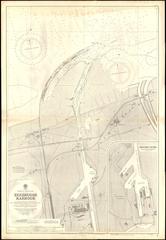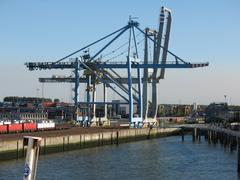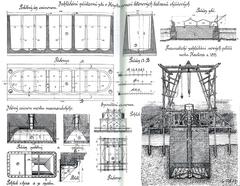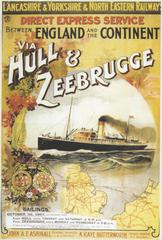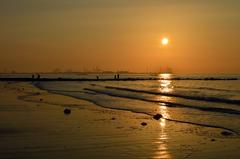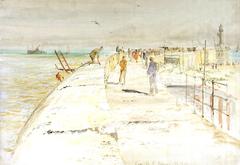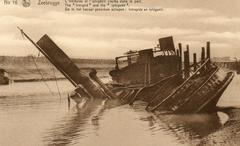
Port of Zeebrugge Visiting Guide: Bruges, Belgium – Tickets, Hours, and Attractions
Date: 14/06/2025
Introduction: The Port of Zeebrugge – Where History Meets Modern Maritime Excellence
The Port of Zeebrugge, often referred to as “Bruges-by-the-Sea,” stands as a dynamic maritime gateway connecting Belgium to the world. Its roots stretch back over 10,000 years, shaped by the evolving North Sea coast and the waterways that made Bruges a medieval trading titan (Port of Antwerp-Bruges). Today, Zeebrugge is recognized among Europe’s most significant ports, leading in automotive logistics, roll-on/roll-off (RoRo) cargo, and liquefied natural gas (LNG), and serving as a vital link within the Benelux seaport system (Wikipedia).
While the port itself is primarily a commercial and industrial facility with restricted general access, visitors can immerse themselves in Zeebrugge’s maritime heritage through guided tours, museums, and proximity to Bruges—a UNESCO World Heritage city famed for its canals and medieval architecture (Visit Bruges). This guide provides comprehensive information on Zeebrugge’s history, practical visiting details, accessibility, transportation, and local attractions, ensuring a rewarding experience whether you are a maritime enthusiast, cruise passenger, or cultural explorer (Zeebrugge Cruise Terminal Guide).
Contents
- The Port of Zeebrugge: Historical Timeline and Economic Evolution
- Visiting the Port: Hours, Tickets, and Practical Tips
- Zeebrugge Cruise Terminal: Visitor & Transport Guide
- Seaside and Cultural Attractions in Zeebrugge & Bruges
- Useful Visitor FAQs
- Planning Your Visit: Accessibility, Travel, and More
- Key Events, Festivals, and Local Experiences
- Sources and Further Reading
The Port of Zeebrugge: History and Significance
Prehistoric and Medieval Origins
Zeebrugge’s story begins with the natural formation of the North Sea and its river deltas, which permitted ships to reach deep inland over 10,000 years ago (Port of Antwerp-Bruges). By the 10th century, Bruges had leveraged its strategic waterways to become a center of wool trade with England, rising as a commercial hub in medieval Europe (Spire Maritime). The creation of the world’s first stock exchange in 1309 at Bruges’ Oude Beursplein marked its economic importance.
However, by the 15th century, silting of the Zwin channel diminished Bruges’ direct access to the sea, leading to economic decline (Port of Antwerp-Bruges).
Industrial Vision and Port Construction
A renewed vision in the late 19th century led to the creation of Zeebrugge (“Bruges-by-the-Sea”), with a canal directly linking Bruges to the North Sea. Engineer Auguste de Maere’s plans were realized with the port’s inauguration in 1907 (Spire Maritime). Early development faced setbacks due to limited rail and road links and insufficient hinterland industry (History of Zeebrugge PDF).
Strategic Role in the World Wars
Zeebrugge’s location made it a focal point during both World Wars. In World War I, it was a German U-boat base and the site of the dramatic Zeebrugge Raid in 1918, where British forces attempted to block the harbor (Visit Bruges). The port was rebuilt post-war, and in the interwar years, ferry and train services resumed.
During World War II, the port again saw German occupation before postwar recovery brought government investment in dredging and modernization.
Expansion and Modernization
The 1950s–1980s marked Zeebrugge’s transformation into a modern port, with new shipyards, oil terminals, and major expansion projects. The completion of the Pierre Vandamme lock in 1985 allowed access for the world’s largest vessels (Port of Antwerp-Bruges). Zeebrugge’s cargo volumes soared, and its reputation as a technologically advanced port grew.
21st Century: Innovation and Global Role
Today, Zeebrugge is a leader in specialized logistics (notably as the world’s largest car port), LNG handling, and container traffic. It directly and indirectly supports nearly 30,000 jobs and handles over 50 million tonnes of cargo annually (Wikipedia). Recent integration with the Port of Antwerp created the Port of Antwerp-Bruges—Europe’s largest export port—driving sustainable growth and digital innovation (Spire Maritime).
Visiting the Port: Practical Information
Access, Tickets, and Hours
- Port Access: The commercial port is not open for casual visits; entry to operational areas is restricted. Access is permitted via pre-booked guided tours or for cruise and ferry passengers during scheduled calls.
- Guided Tours & Museums: Maritime museums and historical sites offer visitor access. Check official websites for tour schedules, opening hours, and ticket prices.
- Ferry Terminal: Open in line with ferry schedules, typically 8:00 AM–6:00 PM. Tickets are available online or at the terminal (Ferry Service Timetables and Tickets).
- Harbor Tours: Seasonal guided boat tours depart April–October and can be booked in advance.
- Cruise Terminal: Open to cruise passengers during ship calls, generally 8:00 AM–8:00 PM (Zeebrugge Cruise Terminal Guide).
Accessibility
- For Reduced Mobility: Visitor centers, shuttle buses, and terminals are equipped for wheelchair access. Notify tour providers for specific needs.
- Family-Friendly: Restrooms, cafes, and multilingual info desks are available at key sites.
Transportation
- Shuttle Buses: Frequent shuttles link the port to Bruges (20–30 min), with tickets available at the port or online.
- Train/Tram: Take the port shuttle to Blankenberge station (2 km), then a 15-minute direct train to Bruges.
- Kusttram: Connects Zeebrugge with coastal resorts.
- Taxis/Private Transfers: Available at the port, with fares to Bruges typically €50–€120.
- Car Rentals: Several agencies operate locally (advance booking recommended).
Zeebrugge Cruise Terminal: Visitor & Transportation Guide
Terminal Facilities
- Luggage Storage
- Free Wi-Fi
- Accessible restrooms
- Information desks (multilingual)
Arrival & Disembarkation
- Cruise Ships: Dock at Leopold II dam or Albert II dock. Passengers must use the free shuttle bus to exit the industrial port area.
- Ferry Passengers: Scheduled crossings to Hull, England, with ticketing available online and onsite.
Seaside and Cultural Attractions
Zeebrugge Beach & Promenade
- Open year-round, free access
- Cafes, seafood restaurants, and summer events (Zeebrugge Events)
Maritime Museums
- Seafront Maritime Theme Park: Features a Russian submarine, lightship, and interactive exhibits. Open daily (March–October), 10 AM–6 PM. Tickets: €12 adults, €8 children (Seafront Zeebrugge).
- Fish Auction Hall (Vismijn): Guided tours by appointment, €10/person.
Monuments & Memorials
- Zeebrugge Raid Memorial and British sailors’ graves are open year-round, commemorating WWI history.
Nearby Attractions
- Bruges Historic Center: Medieval architecture, canals, and UNESCO World Heritage sites.
- Lissewege: A picturesque “white village” with a medieval abbey.
- Blankenberge: Belle Époque architecture, pier, and nightlife.
- Sluis (NL): Noted for evening markets.
Events, Festivals, and Local Experiences
- WECANDANCE Festival: Annual electronic music festival in July, tickets €50–€120.
- Fish Festival (Visserijfeesten): Seafood tastings and cultural events, early August.
- Evening Markets: June–September on the Zeedijk, 5 PM–10 PM.
- Parkies Concerts: Free summer concerts in nearby towns.
- Fireworks: National Day and select summer dates.
Outdoor & Family Activities
- Cycling: Bike rentals near the port; access to Kustfietsroute.
- Harbor Cruises: April–October, 11 AM and 3 PM departures; €15–€30.
- Coastal Walks: Enjoy the Zeebrugge lighthouse and scenic viewpoints.
Frequently Asked Questions (FAQ)
Q: Can I visit the port directly?
A: Operational areas are restricted. Access is via pre-arranged tours, cruise/ferry travel, or visitor centers.
Q: How do I get from Zeebrugge to Bruges?
A: Shuttle bus (20–30 min), or port shuttle to Blankenberge station plus a 15-minute train.
Q: Are Zeebrugge’s beaches and promenades free?
A: Yes, they are open 24/7 with no entrance fee.
Q: Is Zeebrugge family-friendly and accessible?
A: Yes, major attractions and transport provide accessibility options and family amenities.
Q: When is the best time to visit?
A: Summer offers the most events and warm weather; spring and autumn are quieter but still pleasant.
Tips for a Smooth Visit
- Book tours and transport in advance, especially during peak seasons.
- Arrive early for shuttle services and allow time for security checks.
- Carry some cash (euros), though cards are widely accepted.
- English is commonly spoken in tourist areas.
- Download the Audiala app for real-time updates, event listings, and travel tips.
Key Milestones in Zeebrugge’s History
- 10,000 years ago: North Sea formation creates natural maritime access (Port of Antwerp-Bruges).
- 1309: Bruges opens the world’s first stock exchange (Spire Maritime).
- 1894–1907: Zeebrugge port and canal constructed.
- 1918: Zeebrugge Raid during WWI (Visit Bruges).
- 1985: Pierre Vandamme lock completed, enabling large vessel access.
- 2021: Merger with Port of Antwerp forms Europe’s largest export port (Wikipedia).
Zeebrugge and Bruges: Culture, Cuisine, and Coastal Charm
Combining modern port operations with vibrant seaside and cultural experiences, Zeebrugge is the perfect gateway to Bruges’ medieval splendor and the Belgian coast’s laid-back allure. Enjoy fresh seafood at local restaurants, explore maritime museums, attend lively festivals, or simply relax on the broad sandy beach. Whether arriving by cruise, ferry, or day trip, Zeebrugge offers an accessible and memorable destination.
Further Information and Official Sources
- Port of Antwerp-Bruges: Zeebrugge History
- Spire Maritime: Zeebrugge Innovation
- Zeebrugge Port Official Website
- Zeebrugge Cruise Terminal Guide
- Wikipedia: Port of Zeebrugge
- Visit Bruges – Port of Zeebrugge
- History of Zeebrugge PDF
- Seafront Zeebrugge Maritime Theme Park
- Zeebrugge Events
- Ferry Service Timetables and Tickets
- Maritime Executive – Antwerp and Zeebrugge Merger
- Always Pack Tissues – Bruges & Zeebrugge
- Emma Online – Zeebrugge Cruise Port
